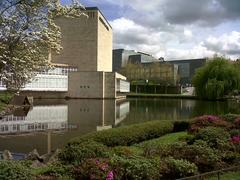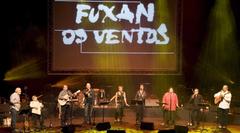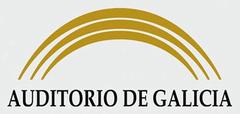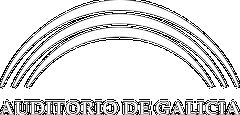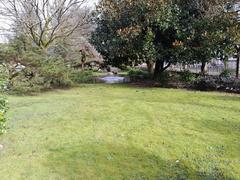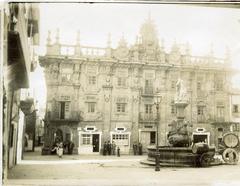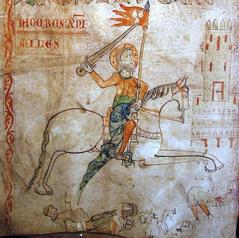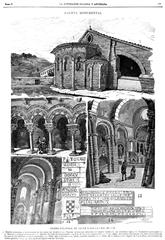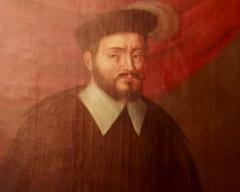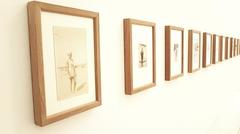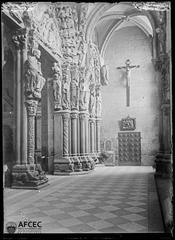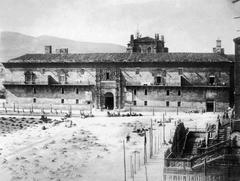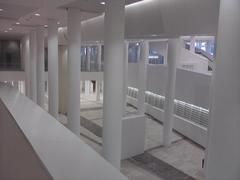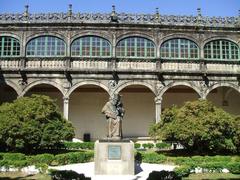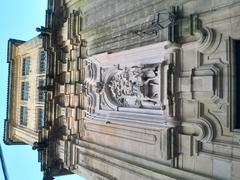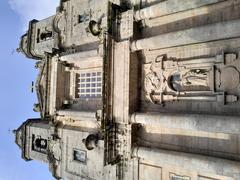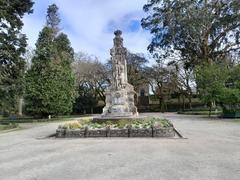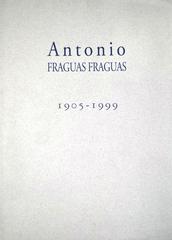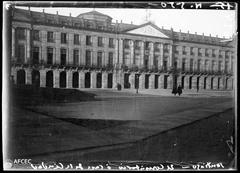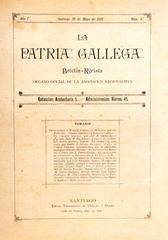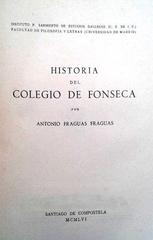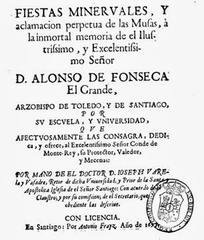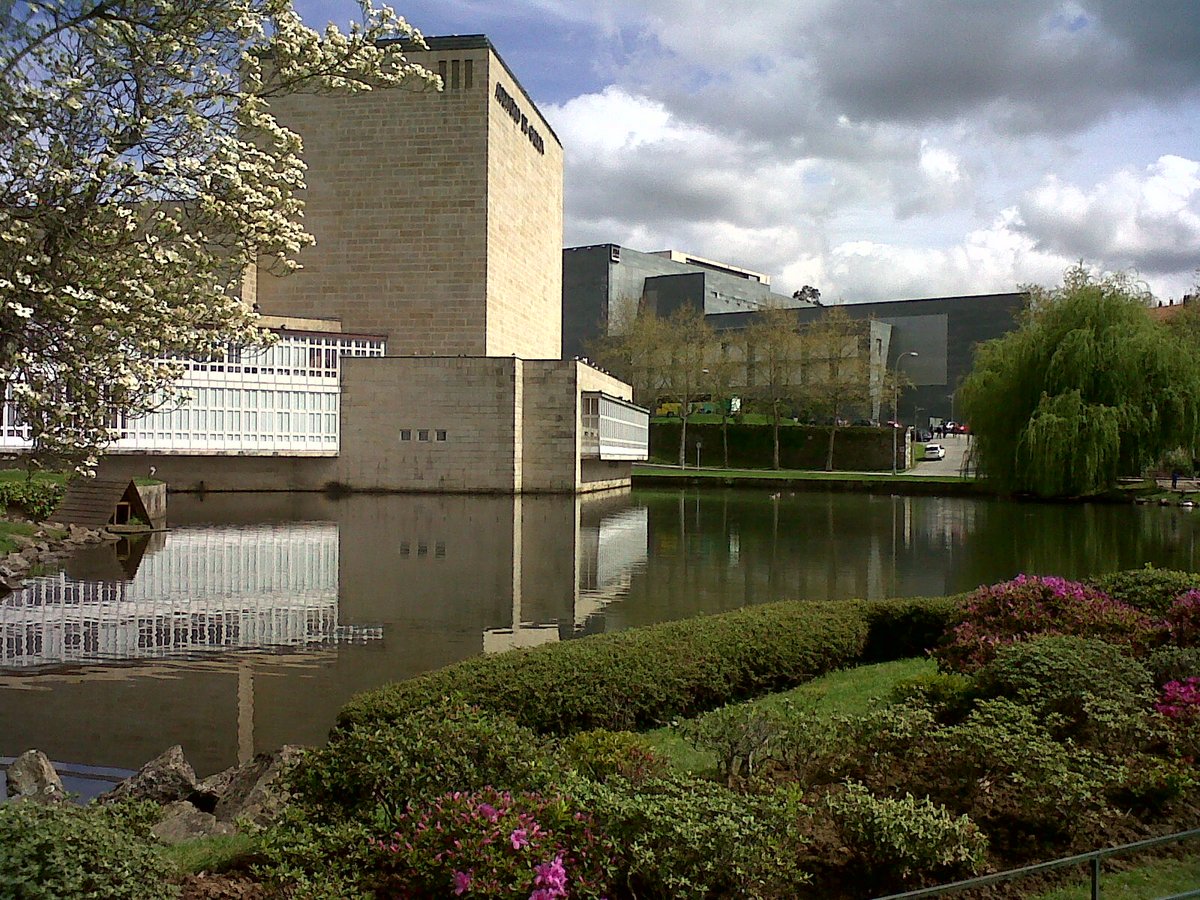
Auditorio de Galicia: Visiting Hours, Tickets, and Complete Visitor Guide to Santiago de Compostela Historical Sites
Date: 15/06/2025
Introduction
Located in the heart of Santiago de Compostela, the Auditorio de Galicia stands as a landmark of modern architecture, musical excellence, and Galician cultural identity. Since its inauguration in 1989, this venue has played a pivotal role in both the city’s and the region’s cultural development. Designed by architects Julio Cano Lasso and Diego Cano Pintos, the Auditorio elegantly fuses local stonework with contemporary glass facades, symbolizing a dialogue between heritage and innovation (SantiagoTurismo; Compostela Cultura).
Serving as the home of the Real Filharmonía de Galicia since 1996, the Auditorio hosts a rich program of concerts, exhibitions, and community events. With accessibility features, educational programs, and a prime location near Santiago’s historic center and Parque da Música, it is an essential stop for both culture seekers and casual visitors (Xunta de Galicia Official Site; Paxinas Galegas).
This guide offers a detailed overview of the Auditorio’s history, architectural highlights, visitor information, and tips for exploring Santiago de Compostela’s other historical treasures.
Historical Background
Foundation and Development
The Auditorio de Galicia was created in response to a collective vision to modernize Spain’s cultural infrastructure. Funded by the Ministry of Culture, Xunta de Galicia, and the local municipality, the project was part of Spain’s National Auditorium Program. Architect Julio Cano Lasso, also known for his 1964 pilgrim hostels, conceived a design that seamlessly connected with the city’s natural and urban landscapes (Wikipedia; SantiagoTurismo).
Construction ran from 1986 to 1989, culminating in a grand opening on October 20, 1989. The building’s robust granite exterior, inspired by Galician masonry, is softened by modern glass galleries offering panoramic views of Parque da Música and the historic city.
Evolution as a Cultural Center
From its inception, the Auditorio has served as a dynamic cultural epicenter, hosting music, theater, dance, exhibitions, and community events. The arrival of the Real Filharmonía de Galicia in 1996 marked a turning point, establishing the venue’s reputation for musical excellence (Paxinas Galegas). Weekly concerts, international guest artists, and diverse programming have made the Auditorio a reference point for cultural life in Galicia (SantiagoTurismo).
Architectural Features and Innovations
Exterior Design
With its monumental granite volumes, the Auditorio pays homage to Galicia’s architectural traditions. The interplay of stone and glass creates a striking visual identity and invites natural light into the structure (ArchDaily). The building’s orientation and integration with green spaces, including the artificial lake in Parque da Música, emphasize a seamless dialogue between built and natural environments (I Love Compostela).
Interior Spaces
Main Halls
- Sala Ángel Brage: The principal concert hall with 1,002 seats, designed for symphonies, opera, ballet, and large-scale events.
- Sala Mozart: A 260-seat venue ideal for chamber music, lectures, and rehearsals.
- Sala Isaac Díaz Pardo: A 1,000 m² exhibition space for contemporary art and temporary shows.
- Sala Circular: An intimate 50-seat room for conferences and presentations (Paxinas Galegas; Compostela Cultura).
Acoustics
Renowned acoustic engineer Lothar Cramer ensured that the main auditorium delivers exceptional sound quality, a highlight for both performers and audiences (Taquilla.com).
Cultural Significance and Community Impact
Promoting Galician Identity
The Auditorio actively fosters Galician language and culture through its programming—hosting concerts, festivals, and events that celebrate regional heritage. The venue is also a setting for exhibitions like “Ollos de vidro. As formas doutra historia de Galicia,” which critically explores Galician history through contemporary art (Historia de Galicia).
Community Engagement & Accessibility
With a commitment to inclusivity, the Auditorio offers accessible architecture, ticket discounts, and educational activities for all ages. Programs include school concerts, artist workshops, and guided tours, contributing to youth development and cultural appreciation.
Economic and Urban Influence
The Auditorio’s central location and diverse programming attract thousands of visitors annually, boosting local tourism and supporting the city’s economy. Its presence has revitalized the surrounding neighborhood and fostered urban development (Xunta de Galicia Official Site).
Environmental Responsibility
Consistent with Santiago’s sustainability goals, the Auditorio employs energy-efficient systems and encourages public transport to reduce its environmental impact.
Visitor Experience: Practical Information
Visiting Hours
- General Opening: The lobby and public areas are typically open from 10:00 AM to 10:00 PM.
- Exhibition Spaces: Sala Isaac Díaz Pardo is generally open daily from 10:00–14:00 and 16:00–20:00.
- Performance Halls: Open during scheduled events; check online for specific times (Compostela Cultura; Santiago Turismo).
Tickets and Reservations
- Purchase: Tickets are available online via Compostela Cultura, at the Zona C Punto de Información Cultural (Tue–Sat, 11:00–14:00, 16:00–19:00), and at the venue one hour before events.
- Pricing: Varies by event; discounts for students, seniors, and groups.
Guided Tours
- Availability: Offered by appointment, focusing on the Auditorio’s architecture and history.
Accessibility
- Step-Free Access: Ramps and elevators to all public areas.
- Wheelchair Seating: Designated areas for wheelchair users and companions.
- Accessible Facilities: Adapted restrooms and assistance services.
Facilities and Amenities
- Spacious Foyer: Functions as both exhibition and waiting area.
- Cloakroom: Available during major events.
- Café/Bar: Open during performances.
- Restrooms: Clean and accessible on all floors.
Getting There
- Address: Av. do Burgo das Nacións, 4A, 15705 Santiago de Compostela, A Coruña.
- Transport: Easily accessible by city bus, taxi, or on foot from the historic center. Limited parking is nearby (Agenda de Teatro).
Traveler Tips
- Arrive Early: At least 30 minutes before your event.
- Dress Code: Smart casual is typical.
- Photography: Not allowed during performances; permitted in exhibition areas.
- Language: Events are primarily in Spanish or Galician.
Event Experience
The Auditorio’s program spans classical and contemporary concerts, theater, dance, festivals, and art exhibitions. Highlights include performances by the Real Filharmonía de Galicia, city-wide festivals, and contemporary art shows (Galicia en Concierto; Santiago Turismo).
Nearby Santiago de Compostela Historical Sites
- Cathedral of Santiago de Compostela: Iconic pilgrimage destination and UNESCO World Heritage Site.
- Old Town: Medieval streets with Obradoiro Square and Raxoi Palace.
- Alameda Park: Panoramic city views.
- Museum of the Galician People: Regional history and culture.
- Abastos Market: Local gastronomy (Disabled Accessible Travel; ArchDaily).
Visuals and Media
- Images: High-quality photos and virtual tours are available on the official website and tourism portals, highlighting the Auditorio’s architecture, interiors, and surrounding parklands.
Frequently Asked Questions (FAQ)
Q: What are the Auditorio de Galicia visiting hours?
A: Public areas are open 10:00–22:00; exhibition spaces 10:00–14:00 and 16:00–20:00. Performance halls open for scheduled events.
Q: How can I buy tickets?
A: Online via the official website, at the Zona C information point, or at the venue before events.
Q: Is the venue accessible for wheelchair users?
A: Yes, with step-free access, elevators, adapted restrooms, and reserved seating.
Q: Are guided tours available?
A: By appointment through the official website.
Q: What historical sites are nearby?
A: The Cathedral, Old Town, Alameda Park, and local museums.
Q: Is photography allowed?
A: Generally not during performances, but permitted in exhibition areas.
Contact Information
- Official Website: Compostela Cultura
- Phone: Listed on the official site.
- In-person: Zona C Punto de Información Cultural (Tue–Sat).
Summary and Final Tips
The Auditorio de Galicia is a must-visit for anyone interested in architecture, music, and Galician culture. Its blend of historic context and modern design, accessible facilities, and diverse programming make it ideal for both locals and tourists. Plan ahead by booking tickets in advance, checking event schedules, and exploring Santiago’s rich historical surroundings (Wikipedia; Xunta de Galicia Official Site; Compostela Cultura; SantiagoTurismo).
Enhance your experience by downloading the Audiala app for up-to-date event notifications, ticket discounts, and personalized recommendations.
Sources and Further Reading
- Auditorio de Galicia, Wikipedia
- SantiagoTurismo – Auditorio de Galicia
- Taquilla.com – Auditorio de Galicia
- Paxinas Galegas – Auditorio de Galicia
- Compostela Cultura – Auditorio de Galicia
- I Love Compostela – Auditorio de Galicia
- ArchDaily – Santiago de Compostela Architecture Guide
- Xunta de Galicia Official Site
